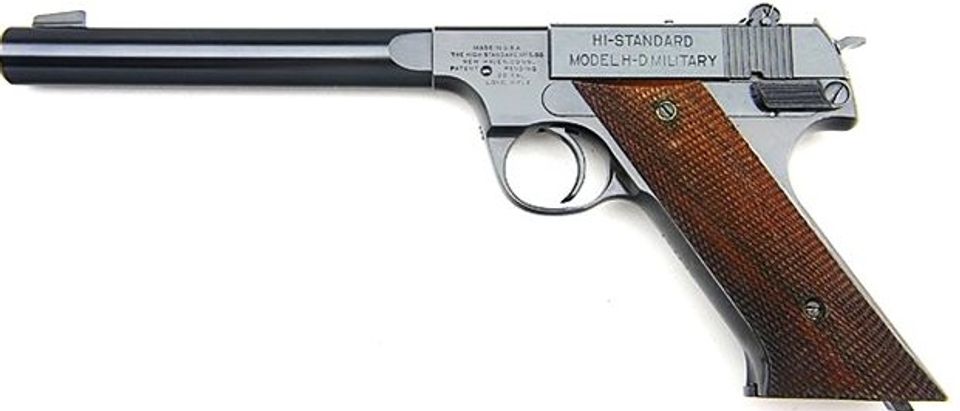By Jim Krieger
Most of our readers know what a plinker is. For those who are new to the shooting sports, “plinker” refers to a rifle or handgun, typically chambered in .22 caliber, and often used for recreational shooting and informal target practice, such as at tin cans for instance, which make a “plink” sound when hit (hence the name “plinker”). There are many guns that make good plinkers, and this series of articles looks at some of the most popular .22 handguns among them. The first four articles in the series may be found here, here, here and here.
Still operating today, over the past 86 years High Standard has produced derringers, pistols, revolvers (both cap-and-ball and cartridge), rifles, shotguns and even the venerable Browning M2 .50 caliber heavy machine gun. During its first forty years, High Standard did a steady trade from government sales, first with .22 pistols before, during and after WWII, and later with riot shotguns (including an innovative bullpup semi-auto) geared to the law enforcement market. At its inception, the company truncated its name to “Hi-Standard” to brand-mark the guns it produced.
The story of the Hi-Standard H-D Military .22 pistol really begins with a firearms designer named Lucius Diehm, whose career started with Colt. After leaving Colt, Diehm then worked for Winchester, and after that, in 1925, he founded the Hartford Arms & Equipment Co. which produced a nine-shot .22 Long Rifle pistol called the Model 1925. In 1932, Diehm’s company went bankrupt, and was purchased by the High Standard Manufacturing Company. High Standard made some modifications to Diehm’s Model 1925 and named it the “Hi-Standard Model B”.
Thirteen years later, in 1945, High Standard introduced the H-D Military. Produced until 1950, the H-D Military was a fairly large pistol (5” tall) that uses a ten round magazine and sports either a 4.5” or a 6.75” barrel. Chambered in .22 Long Rifle, it has rudimentary adjustable sights that are small but functional, and came with checkered walnut grips. The “H” in the model name indicates that the pistol has an exposed hammer, and the “Military” name comes from the fact that it is very similar to its predecessor model, the H-D, that, along with the Model B, was sold in quantities to the War Department as a training pistol for the uniformed services.
Prophetically, given its name, the H-D Military, although purchased by the US in much smaller quantities than the H-D, turned out to be the High Standard pistol that proved to be the one most often publicly associated with government service. The notoriety of the H-D Military began on May 1, 1960 when U-2 spy plane pilot Gary Powers was shot down over the former Soviet Union. Powers was equipped with an H-D Military, serial number 120046, that had been fitted with a suppressor designed by Bell Labs. Powers was publicly tried by the Soviets for espionage, and pictures and descriptions of the pistol and suppressor were splashed across newspapers and magazines around the world. Powers’ suppressed H-D Military was one of approximately 2,600 that High Standard reputedly supplied to the US. Some of these were reportedly sterilized for deniability by being produced without markings, and in the years since Powers’ ill-fated mission, additional tales of clandestine service by these suppressed H-D Military pistols have surfaced, reinforcing the pistol’s status as a Cold War icon.
In its five year production run, approximately 150,000 were produced, and today an H-D Military may be had for about $500 depending on condition. At the range, the H-D Military is a pleasure to shoot, which explains why it was long a favorite of Bullseye competitors. Its weight and long grip make it comfortable to hold, and stable when aiming. The stock sights, being relatively simple and small, leave something to be desired, but they’re sufficient. The trigger pull is consistent, with little take-up and almost no overtravel, and the break is crisp. Although well made, because of its age an H-D Military should probably not be fired with hypervelocity loads. In addition, the pistol can be finicky about consistently feeding rounds loaded with truncated cone bullets. Give it a diet of good quality standard velocity ammo, and the H-D Military will reward you with the kind of performance that makes it a classic plinker.
Jim Krieger is a firearms writer who lives in Texas.


